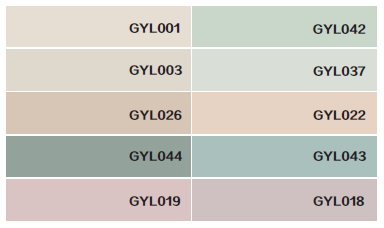
Diatomite colored wall paint and coatings, sourced from high-quality diatomite in the Changbai Mountain region, utilize a new type of active photocatalyst. This enables efficient adsorption and decomposition of formaldehyde, as well as antibacterial and odor-eliminating properties. They also help regulate indoor air humidity. The products have a soft texture and a variety of shapes.

Overview of Silicate Clay Paint
Silicate clay paint is an interior wall decorative material primarily made from silicate clay. Silicate clay is a natural mineral with a porous structure, which endows the paint with excellent adsorption and breathability. It can effectively regulate indoor humidity, purify the air, and provide a unique decorative effect.
Product Features
- Environmental Performance
- The main component of silicate clay paint is natural silicate clay, which does not contain harmful chemical substances such as formaldehyde, benzene, or volatile organic compounds (VOCs). It is a truly environmentally friendly material.
- The paint typically uses a water-based formula in production, further reducing environmental pollution.
- Air Purification Function
- The porous structure of silicate clay gives it a strong adsorption capacity, allowing it to absorb harmful substances from the air, such as formaldehyde, benzene, and ammonia, thereby purifying the air.
- Some silicate clay paints also contain photocatalysts. Through photocatalytic action, these paints can further decompose the adsorbed harmful substances to achieve long-term air purification.
- Humidity Regulation
- Silicate clay paint can absorb and release moisture due to its porous structure. When the indoor humidity is too high, it absorbs excess moisture; when the humidity is too low, it releases moisture to maintain a relatively stable indoor humidity level, improving the comfort of the living environment.
- Decorative Effect
- Silicate clay paint offers a rich variety of textures and patterns. Different decorative effects, such as smooth coating, textured patterns, and relief designs, can be achieved through various application tools and techniques to meet different decorative needs.
- Its colors are soft and natural, avoiding the glaring reflection that can occur with ordinary latex paint, creating a warm and comfortable feeling.
- Fire-Resistant
- Silicate clay is a natural mineral that does not burn and has good high-temperature resistance. It can effectively prevent the spread of fire and provide a certain degree of fire resistance.
- Long Lifespan
- Silicate clay paint has good weather resistance, is not prone to fading or cracking, and can last for 10 to 15 years or even longer under normal use.
Product Composition
- Main Component: Silicate clay is the core ingredient of silicate clay paint, accounting for the majority of the paint’s total weight. It is a natural mineral formed from the deposition of ancient diatom fossils and has a unique porous structure with a porosity rate of over 90%, which is 5,000 times that of activated carbon.
- Auxiliary Components: To improve the performance and application of the paint, some auxiliary materials are added, such as inorganic binders (e.g., cement, gypsum), pigments, and fillers. These components enhance the adhesion, strength, color, and texture of the paint.
- Functional Additives: Some silicate clay paints also include functional additives, such as photocatalysts (for air purification), antimicrobial agents (to prevent mold growth), and humidity regulators (to further optimize humidity control).
Application Process
- Surface Preparation
- The substrate should be flat, dry, free of oil, and dust. If the wall has old paint or wallpaper, it must be removed first.
- For new walls, it is recommended to use specialized putty for leveling. The putty should be environmentally friendly and have high strength.
- After the substrate preparation, the wall surface should be sanded to ensure smoothness and no obvious unevenness.
- Primer Application
- The primer serves to seal the substrate, preventing the alkaline substances and moisture from the substrate from affecting the silicate clay paint. It also enhances the adhesion of the paint.
- The primer is usually applied by rolling or spraying, ensuring an even coat with no missed areas.
- Main Material Application
- The application of silicate clay paint typically requires multiple layers to ensure the thickness and uniformity of the coating.
- The first layer is mainly for leveling the wall. It is usually applied by troweling, with a thickness of about 1–2 mm.
- The second layer can be applied to create different textural effects according to design requirements. For example, a smooth finish can be achieved with a trowel, while various patterns such as wave patterns, feather patterns, and bark patterns can be created with specialized texturing tools.
- For relief effects, multiple layers of troweling and carving are required to form three-dimensional patterns.
- Each application should be allowed to dry before the next one is applied. The drying time is generally about 24 hours, which may vary depending on the ambient temperature and humidity.
- Surface Treatment
- After the application is complete, the surface can be cleaned and maintained as needed. Although silicate clay paint has adsorption properties, surface stains can also be removed through simple cleaning methods, such as gently brushing with a soft brush or wiping with a damp cloth.
Applicable Scenarios
- Residential Use: Suitable for interior wall decoration in living rooms, bedrooms, children’s rooms, and elderly rooms. It provides a healthy and comfortable environment for residents.
- Commercial Spaces: Such as hotels, guesthouses, office buildings, and restaurants. The decorative effect and environmental performance of silicate clay paint can enhance the quality and comfort of the space.
- Public Buildings: Hospitals, schools, and kindergartens, which have high requirements for indoor environments. The air purification function and environmental performance of silicate clay paint can provide better health protection for users.
Precautions
- Application Environment: The ambient temperature should be above 5℃ and the humidity should be below 85% during application to ensure the drying and performance of the paint.
- Color Selection: The colors of silicate clay paint are usually soft. It is recommended to choose colors according to the lighting conditions of the room and the overall decoration style. If the room has poor lighting, light colors are recommended; if the room is well-lit, darker colors can also create a warm atmosphere.
- Cleaning and Maintenance: Although silicate clay paint has adsorption properties, it is important to clean it regularly to avoid excessive dust accumulation that may affect its performance and appearance. Cleaning should be done with soft tools to avoid scratching the wall.
- Lifespan: Although silicate clay paint has a long lifespan, if the wall shows obvious damage or contamination over time, it should be repaired or reapplied in a timely manner to maintain its performance and decorative effect.
